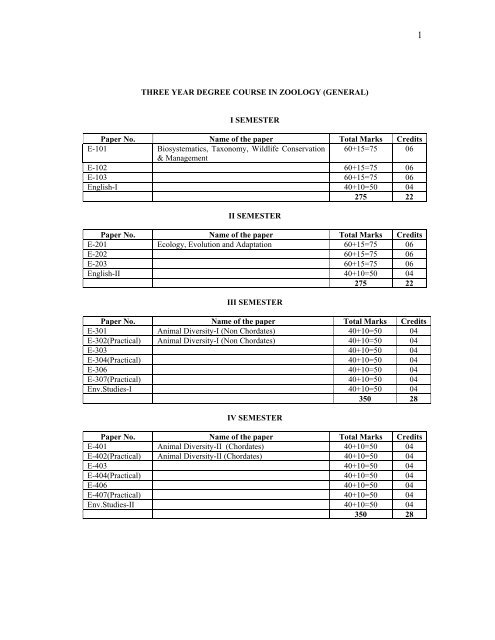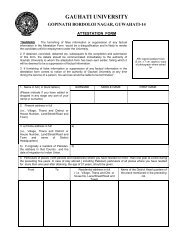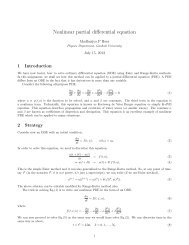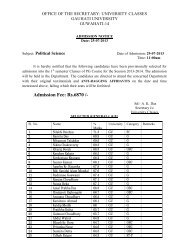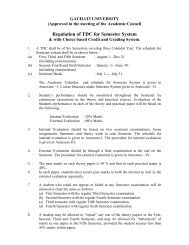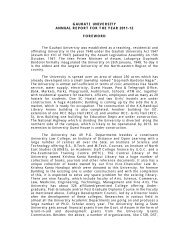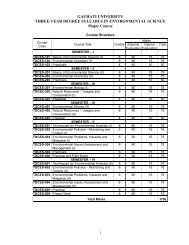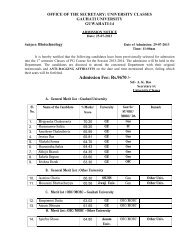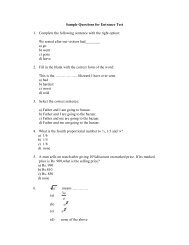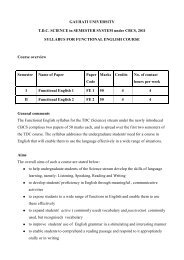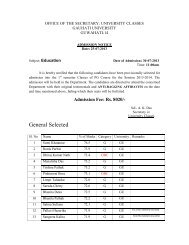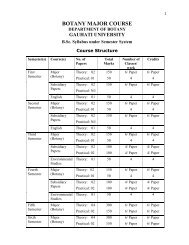THREE YEAR DEGREE COURSE IN ZOOLOGY (GENERAL) I ...
THREE YEAR DEGREE COURSE IN ZOOLOGY (GENERAL) I ...
THREE YEAR DEGREE COURSE IN ZOOLOGY (GENERAL) I ...
You also want an ePaper? Increase the reach of your titles
YUMPU automatically turns print PDFs into web optimized ePapers that Google loves.
1<br />
<strong>THREE</strong> <strong>YEAR</strong> <strong>DEGREE</strong> <strong>COURSE</strong> <strong>IN</strong> <strong>ZOOLOGY</strong> (<strong>GENERAL</strong>)<br />
I SEMESTER<br />
Paper No. Name of the paper Total Marks Credits<br />
E-101 Biosystematics, Taxonomy, Wildlife Conservation 60+15=75 06<br />
& Management<br />
E-102 60+15=75 06<br />
E-103 60+15=75 06<br />
English-I 40+10=50 04<br />
275 22<br />
II SEMESTER<br />
Paper No. Name of the paper Total Marks Credits<br />
E-201 Ecology, Evolution and Adaptation 60+15=75 06<br />
E-202 60+15=75 06<br />
E-203 60+15=75 06<br />
English-II 40+10=50 04<br />
275 22<br />
III SEMESTER<br />
Paper No. Name of the paper Total Marks Credits<br />
E-301 Animal Diversity-I (Non Chordates) 40+10=50 04<br />
E-302(Practical) Animal Diversity-I (Non Chordates) 40+10=50 04<br />
E-303 40+10=50 04<br />
E-304(Practical) 40+10=50 04<br />
E-306 40+10=50 04<br />
E-307(Practical) 40+10=50 04<br />
Env.Studies-I 40+10=50 04<br />
350 28<br />
IV SEMESTER<br />
Paper No. Name of the paper Total Marks Credits<br />
E-401 Animal Diversity-II (Chordates) 40+10=50 04<br />
E-402(Practical) Animal Diversity-II (Chordates) 40+10=50 04<br />
E-403 40+10=50 04<br />
E-404(Practical) 40+10=50 04<br />
E-406 40+10=50 04<br />
E-407(Practical) 40+10=50 04<br />
Env.Studies-II 40+10=50 04<br />
350 28
2<br />
V SEMESTER<br />
Paper No. Name of the paper Total Marks Credits<br />
E-501 Cell Biology, Genetics & Developmental Biology 80+20=100 08<br />
E-502(Practical) Cell Biology, Genetics & Developmental Biology 80+20=100 08<br />
E-505 80+20=100 08<br />
E-506(Practical) 80+20=100 08<br />
400 32<br />
VI SEMESTER<br />
Paper No. Name of the paper Total Marks Credits<br />
E-601 Physiology, Biochemistry and Endocrinology 80+20=100 08<br />
E-602(Practical) Physiology, Biochemistry and Endocrinology 80+20=100 08<br />
E-605 80+20=100 08<br />
E-606(Practical) 80+20=100 08<br />
400 32<br />
TOTAL MARKS FOR TDC (<strong>GENERAL</strong>) <strong>ZOOLOGY</strong> : 2050<br />
TOTAL CREDITS FOR TDC (<strong>GENERAL</strong>) <strong>ZOOLOGY</strong> : 164
3<br />
TDC I SEMESTER (<strong>GENERAL</strong>)<br />
PAPER : E-101<br />
Total Marks:75(60+15)<br />
Total Credits : 6<br />
BIOSYSTEMATICS , TAXONNOMY, WILDLIFE CONSERVATION AND MANAGEMENT<br />
BIOSYSTEMATICS AND TAXONNOMY 45<br />
1. Definition and basic concepts of Biosystematics and Taxonomy.<br />
2. History of Systematics<br />
3. Importance and applications of biosystematics in biology.<br />
4. Trends in biosystematics –concepts of different conventional and newer aspects :<br />
Chemotaxonomy, Cytotaxonomy, Molecular taxonomy<br />
5. Taxonomic procedures-taxonomic collections, preservations, process of identification.<br />
6. Taxonomic keys-different types of taxonomic keys.<br />
7. Concepts of taxonomic terms.<br />
8. Systems of classification.<br />
9. International Code of Zoological Nomenclature.<br />
10. Binominal Nomenclature, Trinominal nomenclature.<br />
WILDLIFE CONSERVATION AND MANAGEMENT 15<br />
1. Definition of wildlife, Wildlife protection act, 1972<br />
2. Principles of wildlife protection and management.<br />
3. Wildlife in N E region with special reference to Kaziranga and Manas National Park.<br />
4. Conservation of Wildlife and importance of biodiversity
4<br />
TDC II SEMESTER (<strong>GENERAL</strong>)<br />
PAPER : E-201<br />
Total Marks:75(60+15)<br />
Total Credits : 6<br />
ECOLOGY, EVOLUTION AND ADAPTATION<br />
ECOLOGY 20<br />
1. Ecology- definition, aim and scope of ecology.<br />
2. Subdivisions of ecology- a) Autecology b) Synecology.<br />
3. Ecosystems-concept, Ecosystem energetics.<br />
4. Ecological succession.<br />
5. Pollution-Air, water, soil and Noise<br />
EVOLUTION 20<br />
1. Concept of Evolution, Macro and Micro Evolution.<br />
2. Origin of life-Spontaneous generation, formation of organic compounds, sources of Energy<br />
and food.<br />
3. Evidences of organic evolution, Embryological Paleontological and Biochemical Evidences.<br />
4. Darwinism and Neo Darwinism.<br />
5. Lamarckism and Neo Lamarckism.<br />
6. Evolution of Man.<br />
ADAPTATION 20<br />
1. Principles of adaptation.<br />
2. Types of adaptations.<br />
3. Volant and aquatic adaptation.<br />
4. Cryptic and warning coloration, Mimicry
5<br />
TDC III SEMESTER (<strong>GENERAL</strong>)<br />
PAPER : E-301<br />
Total Marks:50(40+10)<br />
Total Credits : 4<br />
ANIMAL DIVERSITY-I (NON-CHORDATES)<br />
1. Introduction to Animal Kingdom.<br />
2. PROTOZOA :General characters and outline classification of the Phylum up to order with<br />
examples. Structure, nutrition, locomotion and reproduction of Paramecium.<br />
3. PORIFERA : General characters and outline classification of the Phylum up to order with<br />
examples. Anatomical structures and functions with special reference to canal system of<br />
Sycon.<br />
4. COELENTERATA : General characters and outline classification of the Phylum up to order<br />
with examples. Anatomical structures and functions of Obelia.<br />
5. PLATYHELM<strong>IN</strong>THES : General characters and outline classification of the Phylum up to<br />
order with examples. Structure and life history of Fasciola.<br />
6. ASCHELM<strong>IN</strong>THES : General characters and outline classification of the Phylum up to order<br />
with examples. Anatomical structure and life history of Ascaris.<br />
7. ANNELIDA : General characters and outline classification of the Phylum up to order with<br />
examples. Anatomical structures and functions of Leech.<br />
8. ARTHROPODA : General characters and outline classification of the Phylum up to order<br />
with examples. Anatomical structures and appendages of Prawn. Mouthparts, life history of<br />
Mosquito and Housefly and their roles as vector<br />
9. MOLLUSCA : General characters and outline classification of the Phylum up to order with<br />
examples. Anatomical structures and functions of Pila.<br />
10. ECH<strong>IN</strong>ODERMATA : General characters and outline classification of the Phylum up to order<br />
with examples. Anatomical structures and functions of starfish with special reference to<br />
water-vascular system.
6<br />
TDC III SEMESTER (<strong>GENERAL</strong>)<br />
PAPER : E-302 (PRACTICAL) Marks 50 (40 + 10)<br />
Total Credits : 4<br />
Time : 4 Hrs<br />
(ANIMAL DIVERSITY: NON CHORDATES)<br />
A. Dissection of the following systems of Invertebrate animal (any one) 10<br />
1. Leech i) Urinogenital system.<br />
2. Cockroach i) Digestive system<br />
ii) Nervous system<br />
4. Pila i) Digestive system<br />
B. Mounting<br />
Temporary- Setae of Earthworm, Salivary gland of Cockroach, , Radula of Pila 4<br />
Permanent- Crustacean lavae, Obelia colony, Euglena. 2<br />
(The preparations have to be incorporated in the Practical Note Book. Submission is not required at the<br />
Examination).<br />
C. Identification of prepared slides 4<br />
Polystomella, Sponge spicules, T.S of Ascaris, Miracidium, Cercaria larvae of Liver fluke, T.S. of<br />
Leech (Through crop region). T.S. of Earth worm (through pharynx, gizzard and intestine). Mouth<br />
parts of mosquitoes, Larvae of Glochidium and Echinodermata (Bipennaria)<br />
D. Study of Museum Specimens 10<br />
(Identification and classification upto order. Generic name must be known)<br />
Spongilla, Physalia, Metridium (Seaanemone). Pennatula, (Sea-pen) Gorgonia, Fasciola. Taenia,<br />
Echiurus, Limulus ,Scolopendra (Centipede) Julus (Millipede), Carausius (stick insect), Lepisma,<br />
Mantis, Termite queen, Belostoma (Giant water bug), Peripatus, Chiton, Achatina, Pinctada (Pearl<br />
oyster), Loligo, Mytilus, Limax, Cucumaria (Sea Cucumber), Echinus (Seaurchin).<br />
E. Practical Note Book 4<br />
F. Viva-Voce 6
7<br />
TDC IV SEMESTER (<strong>GENERAL</strong>)<br />
PAPER : E-401 Total Marks 50 (40 + 10)<br />
Total Credits : 4<br />
ANIMAL DIVERSITY-II (CHORDATES)<br />
1. General characters outline classification and plan of body organization in chordates.<br />
2. PROTOCHORDATES : General characters and classification. Structural organization of<br />
Hemichordata (Balanoglossus), Urochordate (Herdmania) and Cephalochordate<br />
(Amphioxious); Affinities of Hemichordates<br />
3. AGNATHOSTOMATA : Classification, Ammocoete larva.<br />
4. PISCES : General characters, classification up to order with characters and examples.<br />
Anatomical structures of Scoliodon. Digestive, Circulatory and Nervous system of Scoliodon,<br />
Distinction between cartilaginous and bony fishes.<br />
5. AMPHIBIA : Distinctive characters and classification up to order with characters and<br />
examples. Anatomical structures of Bufo with special reference to respiration. Metamorphosis<br />
in Amphibia.<br />
6. REPTILIA : Distinctive characters and classification up to order with characters and<br />
examples. Characteristics of poisonous snakes. Poison apparatus and biting mechanism.<br />
7. AVES : Distinctive characters and classification up to order with characters and examples.<br />
Differences between Paleognathae and Neognathae. Flight muscles and flight mechanism in<br />
Bird , Migration of Birds.<br />
8. MAMMALIA : Distinctive characters and classification up to order with characters and<br />
examples. Affinities of Prototheria.<br />
9. General organization of exoskeleton in vertebrates.<br />
10. Comparative anatomy of heart and aortic arch in Vertebrates.
8<br />
TDC IV SEMESTER (<strong>GENERAL</strong>)<br />
PAPER : E-402 (PRACTICAL) Marks 50 (40 + 10)<br />
Total Credits : 4<br />
Time : 4 Hrs<br />
(ANIMAL DIVERSITY: CHORDATES)<br />
1. Dissection of the following systems of vertebrate animals 10<br />
a. Scoliodon: Internal ear, IXth and Xth cranial nerves, afferent and efferent nerves<br />
b. Pigeon - Flight muscles, arterial system<br />
2. Mounting 4<br />
a. Temporary – Blood film of amphibian and mammal, Placoid scale, filoplume.<br />
b. Different types of scales of bony fishes, striated and unstriated muscles, ciliated and<br />
squamous epithelium of vertebrates<br />
3. Identification of Prepared Slides 3<br />
W.M. of Salpa, Doliolum, different types of scales of fishes, T.S of Amphioxus through pharynx.<br />
T.S of intestine, liver, Kidney, testis and ovary of Mammals.<br />
4. Study of Bones 3<br />
Axial and appendicular skeleton of Fowl/ Pigeon.<br />
5. Identification and classification (up to order, Generic name must be mentioned) 10<br />
Pyrosoma, Balanoglossus, Herdmania, Amphioxus Petromyzon, Myxine. Torpedo (Electric Ray)<br />
Pristis, Hippocampus (Sea horse), Monopterus, Cyprinus, Heteropeneustes (Singhi), Clarias<br />
(Magur), Anabus, Labeo (Rohu). Catla, Mystus. Icthyophis. Chameleon, Varanus , Zenochrophis<br />
(Dhora), Alcedo (King fisher), Hystrix (Porcupine), Funambulus (Squirrel), Pteropus or<br />
Sctotophilus (Bat), Echidna, Manis<br />
6. PRACTICAL NOTE BOOK 4<br />
7. VIVA –VOCE 6
9<br />
TDC V SEMESTER (<strong>GENERAL</strong>)<br />
PAPER : E-501 Total Marks 100 (80 + 20)<br />
Total Credits : 8<br />
CELL BIOLOGY, GENETICS AND DEVELOPMENTAL BIOLOGY<br />
CELL BIOLOGY 30<br />
1. Structure of Prokaryotic and Eukaryotic cells.<br />
2. Virus-Structure and assembly.<br />
3. Cell theory.<br />
4. Structure and function of plasma membrane, membrane transport.<br />
5. Cell reproduction- Mitosis and Meiosis.<br />
6. Ultra structure and function of Mitochondria. Golgi bodies, Endoplasmic Reticulum and<br />
Ribosome.<br />
7. Chromosome- Ultrastructure and organization, Giant chromosomes-Types and<br />
Significance.<br />
GENETICS 25<br />
1. Linkage-its mechanism and significance.<br />
2. Crossing over-its mechanism types and significance.<br />
3. Sex linkage, Sex linked inheritance.<br />
4. Chromosomal sex determination.<br />
5. Varieties of gene expressions- multiple alleles, lethal genes, pleiotropic genes, epistasis<br />
6. Mutation- a) Chromosomal aberration b) Gene mutation c) Harmful and beneficial effects of<br />
mutation.<br />
.<br />
DEVELOPMENTAL BIOLOGY 25<br />
1. Gametogenesis –Spermatogenesis and Oogenesis.<br />
2. Fertilization- Sperm egg interactions, Activation of egg, Gamete fusion in<br />
Sea urchin.<br />
3. Types of egg and cleavage pattern.<br />
4. Concept of organizer and induction<br />
5. Extra embryonic membranes in Birds and Mammal.<br />
6. Reproductive cycles in vertebrates.<br />
7. Regeneration in Vertebrates and invertebrates.<br />
8. Parthenogenesis
10<br />
TDC V SEMESTER (<strong>GENERAL</strong>)<br />
PAPER : E-502 (PRACTICAL) Total Marks 100 (80+ 20)<br />
Total Credits : 8<br />
Time : 6 Hrs<br />
(CELL BIOLOGY, GENETICS AND DEVELOPMENTAL BIOLOGY)<br />
1. Study of different type of cells (Representatives of prokaryotic and eukaryotic cell)<br />
3. Staining techniques of nucleus and nucleolus<br />
4. Study of mitosis in onion root tip/tadpole tail.<br />
5. Study of meiosis in Grasshopper/ Grylotalpa.<br />
6. Study of different tissue through permenent slides : Epithelial (Simple, squamous, cuboidal,<br />
columnar, Compound, stratified, transitional, muscular, bon, cartilage, areolar, tandon, adipose,<br />
reticular and nervous)<br />
8. Staining of Barr body from buccal epithelium.<br />
9. Study of slides of blastula, gastrula, and nurula of Amphioxus and Frog \Toad.<br />
10. Study of specific stages of development of chick embryo through prepared slides<br />
PRACTICAL NOTEBOOK 5<br />
VIVA VOCE 10
11<br />
TDC VI SEMESTER (<strong>GENERAL</strong>)<br />
PAPER : E-601 Total Marks : 100 (80 + 20)<br />
Total Credits : 8<br />
PHYSIOLOGY, BIOCHEMISTRY AND ENDOCR<strong>IN</strong>OLOGY<br />
PHYSIOLOGY 35<br />
1. Chemical foundation of Physiology- solutions, osmotic pressure, diffusion, PK and PH,<br />
buffer.<br />
2. Physiology of digestion- Digestion of carbohydrates, fats and protein. Function of liver and<br />
pancreas. Absorption of dietary components.<br />
3. Respiration- Exchange of gases, oxygen transport, respiratory pigments. Oxygen association<br />
and dissociation Transport and removal of CO2<br />
4. Excretion- Nitrogenous wastes, ammonotelic, uriotelic and uricotelic modes of excretion.<br />
Physiology<br />
5. Blood-Composition and functions of blood and lymph, Blood group, Blood coagulation<br />
6. Initiation and conduction of nerve impulse. Neurotransmitters.<br />
BIOCHEMISTRY 15<br />
1. Biomolecules- Structure, classification and biological significance of Carbohydrate, protein<br />
and Lipid.<br />
2. Enzyme- classification and mechanism of enzymatic action<br />
3. Cellular respiration<br />
ENDOCR<strong>IN</strong>OLOGY 15<br />
1. Brief outline of the organization of endocrine system in mammals with special reference to<br />
pituitary gland and gonads.<br />
2. Regulation of hormone secretion.<br />
BIOSTATISTICS 15<br />
1. Utility of biostatistics.<br />
2. Mean-Arithmetic,Geometric and Harmonic mean; Median and Mode.<br />
3. Standard deviation and standard error of mean.<br />
4. Graphic presentation of data-Histogram, Bar diagram, Pie diagram
12<br />
TDC VI SEMESTER (<strong>GENERAL</strong>)<br />
PAPER : E-602 (PRACTICAL) Total Marks : 100 (80+20)<br />
Total Credits : 8<br />
Time : 6 Hrs<br />
(PHYSIOLOGY, BIOCHEMISTRY AND ENDOCR<strong>IN</strong>OLOGY)<br />
1. Determination of Blood groups in man<br />
2. R.B.C, W.B.C –Total counts.<br />
3. Preparation of Haemin crystal<br />
4. Biochemical detection of carbohydrate (Mono, di and polysaccharides/ glucose, fructose<br />
sucrose, polysaccharide) Protein and lipid<br />
5. Enzyme- qualitative detection of salivary amylase.<br />
6. Dissection of Pituitary, Thyroid, Pancreas in Rat/Rabbit<br />
7. Dissection of Weberian ossicle in fish.<br />
8. Dissection of Pituitary gland of fish<br />
9. Practical Record 5<br />
10. Viva voce 10


